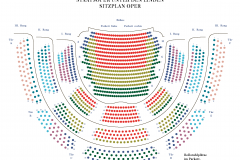Nabucco
Mo | Tu | We | Th | Fr | Sa | Su |
Nabucco
Dramma lirico in four parts (1842)
Music from Giuseppe Verdi
Text from Temistocle Solera
Duration: Approximately 2 hours and 40 minutes, including one intermission
Language: Performed in Italian with German and English surtitles
Recommended Age: Suitable for ages 14 and up
It was his first great success, in a sense, his breakthrough: Nabucco. Premiered at Milan’s Scala in the spring of 1842, this work marks the start of the brilliant career of Giuseppe Verdi, who would become the leading Italian opera composer, going virtually unrivalled for decades. Set in biblical times in Jerusalem and Babylon, Nabucco deals with the fates of two peoples and cultures, but also the arrogance of the protagonist, who with an inflated sense of self-importance declares himself a god, only then to descend into madness. Tableaux with ceremonial gestures and poignant music, such as the famous chorus “Va pensiero” sung by the imprisoned Hebrews, are combined with scenes of intense expression, filled with drama and passion.
This will be the first production at the Staatsoper by the renowned director of opera, theater, and film Emma Dante. Bertrand de Billy, widely acknowledged as a Verdi specialist, will conduct the impressive and powerful work.
Plot
Part One
Jerusalem – The Babylonian king Nabucco and his troops besiege Jerusalem. The Hebrews gather at Solomon’s temple to pray for God’s help. The High Priest Zaccaria insists that they do not give up hope, since they are holding Nabucco’s daughter Fenena hostage. She once freed Ismaele, the nephew of the king of Jerusalem, in Babylon and followed him out of love back to the city. But now, Ismaele wants to help her flee. The plan is thwarted by Fenena’s sister Abigaille, who is able to get into the temple with her Babylonian soldiers thanks to a disguise. Not only Fenena, but Abigaille also loves Ismaele. She presents him with a choice: if he were ready to return her love, she would be ready to protect him and his people. But Ismaele cannot declare his love for her. By now, Nabucco has taken the city. Zaccaria wants to protect the temple from desecration and threatens the Babylonian king with Fenena’s execution. Out of love for Fenena, Ismaele disarms the High Priest and thus seals the fate of his people. Nabucco orders the destruction of the temple.
Part Two
The Impious One – Back in Babylon, Abigaille discovers a secret document that reveals her true origin. As the daughter of a slave, she is not Nabucco’s legal successor: Fenena is. The king has transferred the rule over Babylon to Fenena during his absence, and she decides to free the imprisoned Hebrews. Horrified by this, the priests of Baal decide to support Abigaille: by spreading the fictive news of Nabucco’s death, Abigaille is to seize power.
The Levites blame Ismaele for the imprisonment of the Hebrews. But Zaccaria calls on all to forgive and announces that Fenena has converted to the Jewish faith. After the news of Nabucco’s supposed death is announced, Abigaille demands the crown from Fenena. But suddenly, the supposedly dead king himself appears and demands that he should now be worshipped as the only God. The blasphemer is struck by lightning and punished with madness. Abigaille seizes the moment and takes the crown.
Part Three
The Prophecy – Deceived by Abigaille’s deception, Nabucco, who has still not regained his wits, signs the death sentence for the Hebrews. He realizes that he has just sealed the fate of his daughter Fenena. When he threatens Abigaille with revealing her true origins, she destroys the documentation of her mother’s identity before Nabucco’seyes and has the king arrested.
Full of sadness and longing, the imprisoned Hebrews recall theirhomeland. Zaccaria prophesies a better future and calls on them to summon new courage.
Part Four
The Broken Idol – When the imprisoned Nabucco learns that theexecution of the Hebrews and Fenena is being planned, he pleads to the God Jehovah and asks for forgiveness. With the assistance of his officer Abdallo, he succeeds in freeing himself.
Nabucco prevents the execution and has the idol of Baal destroyed. He grants the prisoners freedom and promises to erect a new temple for Jehovah. The dethroned Abigaille has taken poison and dies, after beseeching Fenena for forgiveness.
Program and cast
Musical Director: Francesco Lanzillotta
Director: Emma Dante
Set Design: Carmine Maringola
Costumes: Vanessa Sannino
Light: Cristian Zucaro
Choreography: Manuela Lo Sicco
Nabucco: Igor Golovatenko
Ismaele: Andrés Moreno García
Abigaille: Anastasia Bartoli
Fenena: Elena Maximova
Zaccaria: Tareq Nazmi
Anna: Sonja Herranen
Abdallo: Junho Hwang
Hohepriester des Baal: Hanseong Yun
Staatsopernchor, Staatskapelle Berlin
State Opera Unter den Linden
Staatsoper Unter den Linden is one of Berlin's most prestigious opera houses, with a rich history and significant cultural impact.
History:
The Staatsoper Unter den Linden was originally built between 1741 and 1743, under the direction of architect Georg Wenzeslaus von Knobelsdorff. It was commissioned by Frederick II of Prussia and was initially named the Königliche Oper (Royal Opera). The opera house has undergone several renovations and reconstructions, notably after World War II damage. It reopened in 1984, following a major renovation.
Construction:
The original design was characterized by its Baroque style, featuring an elegant façade and a grand entrance. The building was reconstructed in the 1950s and 1980s, maintaining its classical exterior while modernizing the interior. The façade features a classic portico with six Corinthian columns and a prominent central pediment.
Interior:
The interior is known for its opulent and classical design. The auditorium is renowned for its acoustics and grandeur, with luxurious velvet seats and elaborate decorations. The stage and seating areas have been updated to meet modern performance standards while preserving historical aesthetics.
Concerts and Performances:
The Staatsoper Unter den Linden hosts a variety of performances, including operas, orchestral concerts, and ballet. It is home to the Staatskapelle Berlin, one of Germany's leading orchestras. The opera house is celebrated for its high-quality productions and its role in Berlin’s vibrant cultural scene.
JOURNEY
The Staatsoper Unter den Linden has completely barrier-free access due to its excellent public transport connections.
ADDRESS: Unter den Linden 7; 10117 Berlin
SUBURBAN RAILWAY
S+U Friedrichstraße (S1, S2, S5, S7, S25, S75)
SUBWAY
Hausvogteiplatz (U2)
Museumsinsel (U5)
Stadtmitte (U2, U6)
Unter den Linden (U5, U6)
BUS
Staatsoper (100, 245, 300)
Unter den Linden/Friedrichstraße (100, 147, 245, 300, N6)
PARKING
Q-PARK parking garage Unter den Linden/Staatsoper
Bebelplatz, 10117 Berlin
There are five electric charging stations in the parking garage. Further information can be found here.
The underground car park on Bebelplatz offers disabled parking spaces and direct access to the opera house. On entering the car park between 5.30pm and 11.30pm, the maximum parking fee is €7. To use this tariff, enter your parking ticket in one of the pay machines and the message »Theatertarif« will appear on the display. Please note that it is not possible to use the tariff if you enter the car park before 5.30pm. so it will not be shown on the display. TIP: If you pay the theatre tariff at the pay machine before the event, you can avoid unnecessary waiting after the show.

 EN
EN DE
DE IT
IT FR
FR ES
ES RU
RU JP
JP RO
RO
 Seating plan
Seating plan 